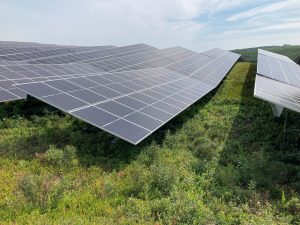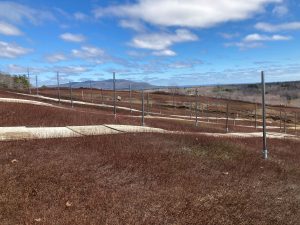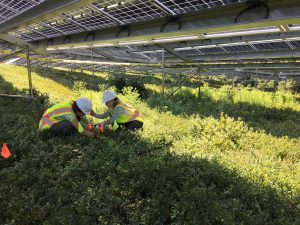Considerations for Solar on Wild Blueberry Land in Maine
Considerations for Solar on Wild Blueberry Land in Maine (PDF for printing)
By Lily Calderwood, Ph.D., Wild Blueberry Specialist and Associate Professor of Horticulture, University of Maine Cooperative Extension, Jordan Parks, Wild Blueberry Research Technician, University of Maine Cooperative Extension, and Leala Machesney, Wild Blueberry Research and Extension Professional, University of Maine Cooperative Extension
Introduction

As Maine’s solar industry continues to grow, landowners are increasingly considering incorporating solar panels into their farmland as an additional source of income (Maine Department of Agriculture, Conservation and Forestry, n.d.). One pathway to incorporate solar arrays into productive farmland is dual-use solar. Dual-use solar, or agrivoltaics, has been shown to be successful on grazing land and is being explored in several commercial cranberry operations in Massachusetts (Ghosh, 2023; Sandler et al., 2019). Installing solar panels above crops could potentially increase field profitability by generating income in addition to crop sales over the same footprint. In addition, as annual temperatures continue to rise and drought events become more frequent and severe, the shade under solar panels may protect plants from extreme heat.
University of Maine Research Conclusions as of 2025
Overall, our research has led us to the following major conclusions. Details on how the research was conducted are described in subsequent sections.
- Wild blueberry plants recovered well from all solar installation treatments.
- When considering a solar array, decide if it the main goal is to produce food or energy.
- Wild blueberry is not currently a profitable crop to manage in a dual-use system due to the amount of shading that occurs under a typical solar array. If you insist on managing the crop underneath solar panels, plan to manage the crop underneath differently accounting for changes in weed and disease pressure and changes in harvesting logistics.
- Wild blueberry plants that were shaded by 30-70% shade showed a trend towards lower yield. Shaded plants had significantly larger leaf size.
Our Experience with Solar Development
The UMaine Cooperative Extension team has only worked on one site that was developed into solar. During this experience, we worked with BlueWave Solar who identified the land and designed the project. Then, we worked with CS Energy, a construction company, who installed the array while communicating with BlueWave. Finally, once installation was complete and the array was connected to the grid, we worked with Navisun, who is the final owner of this array. We worked with all three companies over the course of one year. The UMaine Extension team, the land manager/farmer, and landowner all worked with the same three companies.
Challenges of Dual-use Solar
Determine your Primary Goal
Carefully consider if your primary goal is to produce energy or crops. Wild blueberry crop management was extremely challenging due to physical obstruction by the arrays, and plants produced larger leaves and fewer berries when exposed to shade. If your primary goal is energy production, consider installing solar arrays on land that is less productive and/or on soils that are not of agricultural importance, according to the USGS Web Soil Survey (n.d.).
Choose the Right Spacing
It is important to consider the spacing between solar panel rows when installing solar over an agricultural crop if dual use is the goal. Growing plants under solar panels may shade them excessively and reduce the crop’s ability to photosynthesize, reducing yield and growth. Wild blueberry and cranberry are both “full sun” plants that require a minimum of 6 to 8 hours of direct sunlight per day to achieve maximum yields (Hall, 1955; University of Maine Cooperative Extension, 2016). Traditional solar arrays built for maximum energy production are installed with approximately 8 feet between solar panel rows and are low to the ground. In Rockport, the lower edge of panels was about 4 feet off the ground and on the higher side panels were about 8 feet off the ground. In Massachusetts, some cranberry producers have designed and built arrays that are 25 feet between panel rows and are 8 feet off the ground. Wider spacings make crop management activities, such as weeding, spraying, fertilizing, and harvesting possible. Working with solar developers to design an array that works for your farm is critical and possible. Make sure your existing equipment can fit between solar panel rows. Maintain frequent and consistent communication with the construction company when undergoing the installation of a dual-use solar array to ensure appropriate panel arrangement.
Ensure you have Three Phase Power
Three phase power is required for the installation of solar arrays. However, much of Maine’s energy grid is outdated and much of rural Maine lacks access to three phase power as a result. Ensure you have three phase power before having any solar development conversations.
Understand Regulations Specific to Maine
As the New England solar industry continues to grow and evolve, it is critical to understand regulations and restrictions may differ from state to state. University of Maine Cooperative Extension organized an agrivoltaics knowledge sharing meeting on November 14, 2023, between Government agencies and solar developers in Maine and Massachusetts to categorize the challenges and key differences of solar array installation between these states. For example, Massachusetts landowners must use a shading analysis tool developed collaboratively by the Solar Massachusetts Renewable Target Program (SMART), the Massachusetts Department of Energy and Resources (DOER) to validate that the maximum reduction in sunlight resulting from a proposed array does not exceed 50% during the growing season. While validating shade percentage is currently not a requirement for Maine solar panel installation, this may change in the future and those interested in solar development should work with the State of Maine Department of Agriculture, Conservation, and Forestry (DACF) to ensure compliance.Maine law on the installation of solar arrays is continually evolving to balance increased interest in developing prime agricultural land with mitigation of potential environmental and economic risks associated with installation. LD 1881, passed by the Maine legislature in May of 2023, issued a directive for the DACF and the Maine Environmental Protection Agency to develop definitions on what constitutes prime agricultural land, the fees associated with solar development on prime agricultural land, and guidelines on how to waive or reduce these fees by placing a separate portion of land into conservation easements (Maine Legislature, 2023). This legislation is still under development as of February 2025 but is projected to be reviewed this year (Cough, 2025). Those interested in solar development should work with their municipal accessor when considering solar arrays to determine the potential tax consequences relative to placement. For questions or additional considerations contact the DACF and refer to the DACF publication “Technical Guidance for Utility-Scale Solar Installation and Development on Agricultural, Forested, and Natural Lands.”
Description of UMaine Research Conducted
The Calderwood lab began a research project in 2021 to 1) understand the impact of installing a solar array on wild blueberry land and 2) collect baseline data on wild blueberry productivity under solar panels (Calderwood, Scallon, & Tooley, 2023). This array was in Rockport, Maine, and the solar panel row spacing was industry standard at the time of installation, with 8 feet between rows and 4-8 feet between the ground and panels. Based on the results of this work, an additional study was conducted in 2024 to quantify the effects of shade on wild blueberry yield, phenology, and morphology (Calderwood & Parks, 2024).
Installation
Monofacial (one-sided) and bifacial (two-sided) panels were installed in one of three ways:

Standard
Solar arrays were installed according to standard industry practice with no special consideration for the wild blueberry plants growing underneath. Only monofacial panels were installed.
Mindful
The movement of people and equipment was minimized compared to Standard installation. Only bifacial panels were installed.
Careful
The most conservative installation approach. Poly mats were used to protect plants from foot traffic and equipment and movement on and around plants was minimized. Only bifacial panels were installed.
From May 2nd, 2024, to August 8th, 2024, data on chlorophyll content, phenology over time, pest pressure, fruit yield, and quality was collected on replicated wild blueberry plots under all installation methods.
Blueberry cover filled in completely two years after installation and installation did not significantly reduce wild blueberry cover. This array was not built as a true dual-use array because it has spacing very similar to a standard array with rows and panels 4-8 feet off the ground. Shading exceeded 90% reduction in sunlight, thereby reducing wild blueberry yield dramatically. It was very difficult for the farmer to manage the space under panels due to guy-wires on every other panel. This field has not been commercially harvested since the array was installed due to harvesting difficulties and reduced yield due to shade.
Determining Plant Shade Tolerance
Solar panels and panel arrangement across agricultural fields will continue to evolve, so it is critical to establish a minimum baseline for shade tolerance in wild blueberries. In 2024, a new experiment was established in Jonesboro at Blueberry Hill Farm Agricultural Experiment Station. In this study, wild blueberry plants were grown under full sun as a control and under 30%, 40%, 50%, 60%, and 70% shade created by shade cloth. From May 2, 2024, to August 8, 2024, data on chlorophyll content, phenology over time, pest pressure, fruit yield, and quality was collected on replicated wild blueberry plots. Wild blueberries that were in full sun compared to those shaded by 30-70% shade showed a trend towards higher yield. Shaded plants had significantly larger leaf sizes. Across all research years, wild blueberry plants grown under the shade of solar panels had delayed phenological stage development compared to plants grown in full sun (Calderwood & Parks, 2024; Calderwood & Parks, 2025; Calderwood, Scallon, & Tooley, 2023). Unfortunately, the shade cloths used in this study excluded pollinators, significantly reducing yield under all shade cloth treatments.
Economic Analysis

A complete economic analysis was not possible due to the lack of information publicly available on how much money landowners gain from solar energy. Additionally, managing the wild blueberry underneath the Rockport array was not feasible, and therefore, costs are not applicable. The farmer switched from boom spraying to weed wiping on foot due to the presence of an array. The field has not been harvested since installation.
Acknowledgments
We want to thank Northeast SARE grant LNE22-448R (2022-2024) and BlueWave (2021) for providing the project funding that made this work possible. We thank BlueWave, Navisun, and Solar Agricultural Services for their collaboration and expertise. Thank you to Paul Sweetland who manages the wild blueberry field in Rockport where research took place. Finally, thank you to Patrice Sisson, Abby Cadorette, Charlie Cooper, Julian LaScala, Caroline Klemmer, James McKinney, Drew Parent, and Jordan Ramos for their data gathering and analysis assistance.
References
Calderwood, L., & Parks, J. (2024). Investigating dual-use solar in wild blueberry. In 2023 Wild Blueberry Research and Extension Reports (pp. D134-137). University of Maine Cooperative Extension.
Calderwood, L., & Parks, J. (2025). Wild blueberry response to increasing shade levels. In 2024 Wild Blueberry Research and Extension Reports (pp. D111-D120). University of Maine Cooperative Extension.
Calderwood, L., Scallon, M., & Tooley, B. (2023). Investigating dual-use solar on a wild blueberry field in Rockport. In 2022 Wild Blueberry Research and Extension Reports (pp. D101–D117). University of Maine Cooperative Extension.
Cough, K. (2025, February 21). Regulators move forward with compensation rules for solar on farmland. The Maine Monitor. Retrieved February 24, 2025, from themainemonitor.org/solar-farmland-compensation/
Dyukaryeva, V., & Mallik, A. U. (2023). Shade effect on phenology, fruit yield, and phenolic content of two wild blueberry species in Northwestern Ontario, Canada. Plants, 12(24), 4099. doi.org/10.3390/plants12244099
Ghosh, A. (2023). Nexus between agriculture and photovoltaics (agrivoltaics, agriphotovoltaics) for sustainable development goal: A review. Solar Energy, 266, 112146. https://cdnsciencepub.com/doi/10.4141/agsci-1955-0020
Hall, I. V. (1955). Floristic changes following the cutting and burning of a woodlot for blueberry production. Canadian Journal of Agricultural Science, 35, 142–152. https://cdnsciencepub.com/doi/10.4141/agsci-1955-0020.
Hall, I. V., & Ludwig, R. A. (1961). The effects of photoperiod, temperature, and light intensity on the growth of the lowbush blueberry (Vaccinium angustifolium Ait.). Canadian Journal of Botany, 39(7), 1733-1739. doi.org/10.1139/b61-151
Maine Department of Agriculture, Conservation and Forestry. (2021, August 18). Solar development guidance for Maine municipalities. maine.gov/dacf/ard/resources/docs/dacf-solar-guidance-182021.pdf
Maine Department of Agriculture, Conservation and Forestry. (n.d.). Solar energy & agriculture. Maine.gov. maine.gov/dacf/ard/resources/solar.shtml
Maine Legislature. (2023). An act regarding compensation fees and related conservation efforts to protect soils and wildlife and fisheries habitat from solar and wind energy development and high-impact electric transmission lines under the site location of development laws (HP 1206, LD 1881). legislature.maine.gov/legis/bills/getPDF.asp?paper=HP1206&item=1&snum=131
Sandler, H. A., Mupambi, G., & Jeranyama, P. (2019). Expectations for cranberry growth and productivity under solar panels. University of Massachusetts Amherst. https://scholarworks.umass.edu/entities/publication/f113b215-9812-4e7c-9121-3fe0ba0ed587
University of Maine Cooperative Extension. (2016). Cranberries and a changing climate. University of Maine. Retrieved February 28, 2025, from extension.umaine.edu/cranberries/grower-services/workshops-and-meetings/cranberries-and-a-changing-climate/?utm_source=chatgpt.com
U.S. Department of Agriculture, Natural Resources Conservation Service. (n.d.). Web Soil Survey. United States Department of Agriculture. Retrieved February 28, 2025, from websoilsurvey.nrcs.usda.gov/app/
Information in this publication is provided purely for educational purposes. No responsibility is assumed for any problems associated with the use of products or services mentioned. No endorsement of products or companies is intended, nor is criticism of unnamed products or companies implied.
© 2025
In complying with the letter and spirit of applicable laws and pursuing its own goals of diversity, the University of Maine System does not discriminate on the grounds of race, color, religion, sex, sexual orientation, transgender status, gender, gender identity or expression, ethnicity, national origin, citizenship status, familial status, ancestry, age, disability physical or mental, genetic information, or veterans or military status in employment, education, and all other programs and activities. The University provides reasonable accommodations to qualified individuals with disabilities upon request. The following person has been designated to handle inquiries regarding non-discrimination policies: Director of Equal Opportunity and Title IX Services, 5713 Chadbourne Hall, Room 412, University of Maine, Orono, ME 04469-5713, 207.581.1226, TTY 711 (Maine Relay System).
